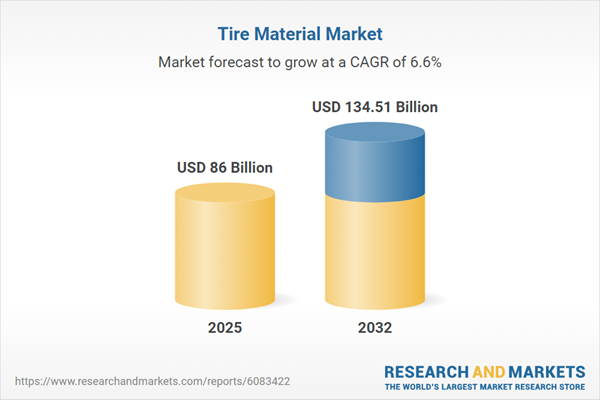Speak directly to the analyst to clarify any post sales queries you may have.
The global tire material market is evolving rapidly as industry leaders respond to a shifting regulatory landscape, advances in material science, and changing mobility demands. Senior executives must focus on innovation, sustainability, and agile procurement to maintain a competitive edge in this environment.
Market Snapshot: Tire Material Market Size and Growth
The tire material market expanded from USD 80.77 billion in 2024 to USD 86.00 billion in 2025 and is forecasted to grow at a 6.58% CAGR, reaching USD 134.51 billion by 2032. This upward trajectory is shaped by rising demand for advanced materials that enhance tire performance across safety, efficiency, and sustainability metrics. Continued innovation in polymers, fillers, and processing methods is driving material optimization, while regulatory requirements and consumer expectations are accelerating the shift toward bio-based and recycled inputs. Leading manufacturers, material suppliers, and automotive OEMs are investing in research and forging new collaborations to capture market opportunities and address fast-moving requirements.
Scope & Segmentation of the Tire Material Market
This report delivers a strategic analysis of tire material market trends, technologies, and segment dynamics, supporting informed decision-making at the executive level. The segmentation includes key industry areas reflecting the primary drivers of demand and supplier differentiation:
- Vehicle Types: Commercial and passenger vehicles, covering a spectrum of performance and cost priorities for diverse end users.
- Construction Types: Bias and radial tire constructions, each offering distinct durability, ride quality, and application advantages.
- Technologies: Run flat, self-sealing, and smart tire innovations, each supporting safety, convenience, and real-time data collection needs.
- Material Types: Natural rubber, including ribbed smoked sheet and technically specified variants, as well as synthetic rubber such as polybutadiene and styrene butadiene, address a broad range of resilience and processing requirements.
- Distribution Channels: Original equipment manufacturer channels and replacement markets, each shaped by unique supply chain and value drivers.
- Applications: Off-road applications (agriculture, construction, mining) and on-road scenarios (urban and highway), illustrating how specific material choices align to operational needs and customer preferences.
- Regions: Americas (North and South), Europe, Middle East, Africa, and Asia-Pacific. Each region is distinguished by supplier focus, regulatory nuance, and levels of innovation and manufacturing capacity.
- Leading Suppliers: Comprehensive coverage includes China Petroleum & Chemical Corporation, LANXESS AG, Evonik Industries AG, Cabot Corporation, Birla Carbon Private Limited, Orion Engineered Carbons GmbH, PPG Industries, Inc., Wacker Chemie AG, Phillips 66 Company, and Tokai Carbon Co., Ltd.
Key Takeaways for Senior Decision-Makers
- Adoption of innovative tire materials is crucial for aligning with evolving mobility patterns and stricter safety and environmental standards worldwide.
- There is heightened interest in bio-derived and recycled elastomers as supply chains adapt to new regulations and resource limitations.
- Collaborative research ecosystems, linking chemical producers, tire manufacturers, and research institutes, accelerate the introduction of new compounds and reinforcement approaches.
- Shifts in procurement strategies reflect increasing volatility in raw materials and the growing need for regional diversification to mitigate geopolitical risks.
- The integration of smart tire technologies unlocks real-time monitoring and predictive maintenance capabilities, offering tangible benefits to fleets and original equipment manufacturers.
- Regional strategies differ, with the Americas emphasizing bio-production and resilience, EMEA advancing in recycling initiatives and circularity, and Asia-Pacific setting benchmarks in rapid, digitized manufacturing.
Tariff Impact: Strategic Response to U.S. 2025 Tariff Measures
With upcoming U.S. tariffs on imported synthetic rubber and specific chemical inputs, participants across the tire material market are reassessing production footprints, sourcing strategies, and partnership models. Stakeholders are evaluating options such as domestic expansion, near-shoring, and increased inventories to control costs. Market leaders focus on optimizing supplier networks and overall expenses, while smaller companies and aftermarket suppliers must balance product mix and R&D investments. This environment demands agile sourcing and procurement strategies to ensure business continuity and competitive positioning.
Methodology & Data Sources
Our analysis is built on structured interviews with industry specialists, detailed reviews of regulatory documents, technical journals, and patent disclosures. Findings are validated through analytical modeling and expert cross-checks to ensure reliability and strategic relevance for executives.
Why This Report Matters
- Enables executives to proactively navigate regulatory, technological, and supply chain shifts within the tire material sector, supporting sound strategic choices.
- Benchmarks supplier performance and guides entry or regional expansion planning through insight into sustainable sourcing opportunities and application-specific trends.
- Provides actionable market intelligence, ensuring organizations are prepared to adapt to the next wave of mobility and vehicle standards.
Conclusion
The tire material market is at a pivotal point characterized by continuous innovation and strong collaboration among stakeholders. Strategic investment in flexible sourcing, applied research, and policy adaptation will allow organizations to thrive in changing market conditions.
Table of Contents
3. Executive Summary
4. Market Overview
7. Cumulative Impact of Artificial Intelligence 2025
Companies Mentioned
The companies profiled in this Tire Material market report include:- China Petroleum & Chemical Corporation
- LANXESS AG
- Evonik Industries AG
- Cabot Corporation
- Birla Carbon Private Limited
- Orion Engineered Carbons GmbH
- PPG Industries, Inc.
- Wacker Chemie AG
- Phillips 66 Company
- Tokai Carbon Co., Ltd.
Table Information
| Report Attribute | Details |
|---|---|
| No. of Pages | 184 |
| Published | November 2025 |
| Forecast Period | 2025 - 2032 |
| Estimated Market Value ( USD | $ 86 Billion |
| Forecasted Market Value ( USD | $ 134.51 Billion |
| Compound Annual Growth Rate | 6.5% |
| Regions Covered | Global |
| No. of Companies Mentioned | 11 |









